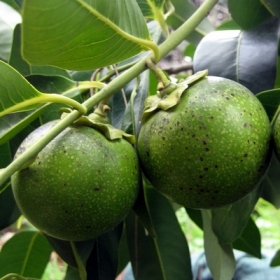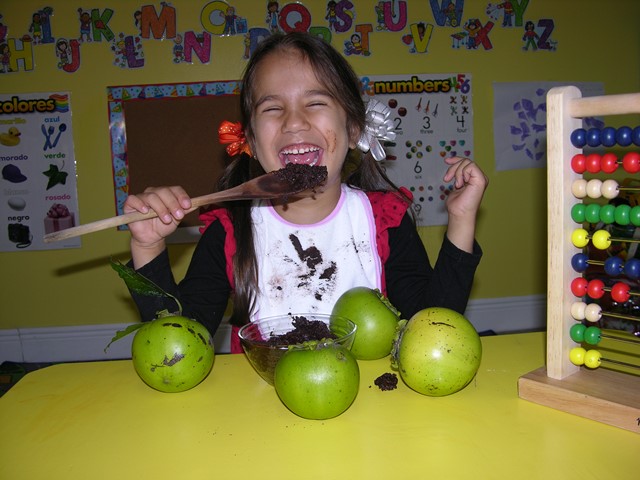From Fairchild
Tropical Botanic Garden
by Noris Ledesma, Curator of Tropical fruit
Chocolate Fruit
for South Florida
As published in the Miami Herald
The chocolate pudding fruit is native to the dry forests of central
Mexico. I remember it well in the markets of Michoacán,
where the fruit is known well and highly appreciated. They often use
the fruit by itself but they sometimes mix the pulp with wine, cinnamon
and sugar and serve as dessert.
The Chocolate persimmon fruit (Diospyros
digyna), a member of the
persimmon family, is native along both coasts of Mexico from Jalisco to
Chiapas, Veracruz and Yucatan. Outside of Mexico it is cultivated in
the Philippines, the Dominican Republic, Cuba, Hawaii and of course on
South Florida.

Growing Chocolate persimmon in South Florida
What to plant:
It is an attractive evergreen tree, 25 ft or more at maturity. Most of
the chocolate pudding fruit in South Florida ripen in October through
March in a time when we have few tropical fruit to enjoy. Because there
are both male and female trees when grown from seed it is preferable to
use grafted trees, which can bear within 3 years. Chocolate pudding
tree should be planted in full sun for best growth and fruit
production. Select a part of the landscape away from other trees,
buildings and structures, and power lines. 'Merida’ is a
grafted variety that can be locally purchased from specialty nurseries.
This variety produces a superior quality fruit in November, which is
much earlier than other selections, and extends the season for 6 to 8
weeks (November – January).
Taking care
of tree: Newly planted chocolate persimmon trees should be
watered at planting and every second or third day for the first couple
of months. Once the rainy season arrives, irrigation should be stopped.
Mature chocolate pudding trees do not need frequent watering and over
watering may cause trees to decline or be unthrifty. Mulching is a
great practice for almost any fruit tree in South Florida. It helps
retain soil moisture, reduces weed problems and improves the soil.
Mulch with a 2- to 6- inch layer of bark, wood chips, or similar mulch
material. Keep mulch 8 to 12 inches from the trunk.
Pruning: Remember
that chocolate persimmon fruit can become large if not pruned to
contain their size. Formative pruning during the first 2 years is
recommended to encourage lateral branching and growth. After several
years of production, it is desirable to cut back the tops of the trees
to 10 feet. Selectively removing a few upper limbs each year will help
prevent the loss of the lower tree canopy due to shading. In addition,
maintaining a smaller tree facilitates tree care and fruit harvest, and
greatly reduces possible storm damage.
Fertilizer: Chocolate
persimmon tree is not demanding in its fertilizer requirements. After
planting, when new growth begins, apply a half to full handful of 8-3-9
or similar fruit tree fertilizer mix. The fertilizer should be
sprinkled lightly below the drip-line of the canopy three times per
year. Take care not to apply the fertilizer to the trunk.
Using the
Fruit: The chocolate persimmon fruit’s shape is
that of a green tomato. The flesh is dark brown or black, rich and
sweet in flavor. The fruit are picked when full size but unripe
(olive-green color) and allowed to ripen in 10 days at room
temperature. The fruit is soft when fully ripe. The fruit can be used
fresh or frozen. Ripe fruit will store for 3 or 4 days under
refrigeration. For longer storage, (6 months) pulp should be removed
from the fruit and frozen.

Danna Velasco
Chocolate persimmon fruit are rich in Vitamin A and Vitamin C, and have
a relatively high amount of potassium. This tropical fruit is a
distinctive element of South Florida cuisine, but must be fully soft
before consumption or use. The fruit by itself has a bland flavor, and
its brilliant gel texture develops caramel flavors when cooked, making
it a great base and desirable filling for pies and other pastry. It is
also made into ice cream.
Tips using
the chocolate pudding fruit:
Pick when full size but unripe (olive-green color) and ripen in about
10 days at room temperature.
Fruit begin to soften and turn brown within 3-6 days after picking. The
flesh is soft when fully ripe.
The fruit can be used fresh or frozen. Ripe fruit will store for 3 or 4
days under refrigeration.
The fruit is delicious eaten fresh or used as a chocolate substitute in
recipes and milkshakes...
Back to
Black Sapote Page
|
|

